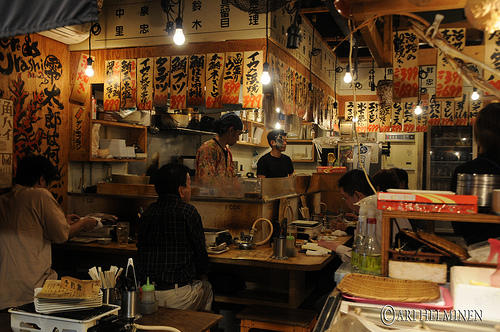Lesson 3 - Notes:
Eating out
(photo
by Ari Helminen used
under terms of Creative Commons license.)

1. Japanese restaurants may be generally classified into those serving
a. traditional fare;
b. a variety of popular dishes;
c.
some specialty,
such as noodles
(udon or soba) or vinegared
rice (sushi);
d. foreign dishes (Mexican, Italian, Chinese, American, and so forth).
The first type of restaurant, called ryōriya, tends to be more formal and expensive, often requiring reservations. The second type is the most common in Japan and the setting is usually fairly casual. While the last three types encompass a wide range of restaurants, they are on the whole less formal and less expensive than the ryōriya. This lesson will focus on situations in these more popular restaurants.
2.
Glass display
cases in front
of most popular
eating places contain paraffin
models of the
dishes and beverages served. Each
dish has a
sign indicating the
Japanese name
and the
price. Most restaurants
use Arabic numerals,
but noodle and sushi
restaurants show the
prices in Japanese characters. Wherever
display cases are
used, there is
no
need for
menus.
In
some eating
places, especially noodle
and sushi
shops, signs showing the
names and prices
of food items
are posted
on the
wall. Some restaurants,
particularly those specializing
in foreign dishes,
have Western-style menus.
3. In most popular restaurants, the customer checks the paraffin models in front, enters, and takes a seat at whatever table is vacant. In small restaurants, when they are crowded, the customer may share a table with strangers rather than wait for a table. A few eating places are arranged so that customers order their meals as soon as they enter and obtain a meal ticket (shokken).
4.
Restaurants serving
popular dishes usually
have complete dinners (tēshoku) in
addition to the
a Ia carte dishes.
If you order
a tonkatsu tēshoku, for
example, you
will get suimono (soup),
tsukemono (pickled
vegetables), and
go-han (rice),
in addition to
the pork cutlet.
5.
If you
are eating in
a restaurant that
serves Japanese or
Chinese food, you
will be expected to
eat with a
pair
of hashi (chopsticks),
unless you ask
for a supun (spoon),
foku (fork),
or naifu (knife).
6. Bottled Japanese beer (bīru) is served in most eating places. If you want to try sake (Japanese wine) with your meal, it is available in most restaurants serving Japanese food. It is usually served hot in a small bottle (o-chōshi) with a small matching cup (sakazuki). If you want tea (o-cha) with your meal, it generally comes with your order at restaurants that serve Chinese or Japanese food.
7.
At some
Japanese restaurants, especially
sushi shops, a
hot, scented washcloth
will be brought to
you soon after you
take a seat.
This is a
refreshing way to
clean your
hands and
face before eating.
Paper products, such as napkins and toilet paper, are not provided in restaurants. You should get in the habit of carrying a small packet of tissues whenever you go out, as the Japanese do.
8.
At popular
eating places, tipping
is not customary. At
ryōriya and
more exclusive restaurants,
a tip is
included in your check
as a service
charge (sābisu-ryō).